X
|
|
| Xenasmatella vaga (previously Phlebiella vaga) (Yellow Cobweb) |
 |
Nov 20, 2022. At Burnham Beeches our small group found a fallen Beech branch with a nice coating of this distinctive corticioid species which in fact appears more like the spreading mycelium of a fungus than the species itself. The common name describes it well and it was previously in genus Phlebiella. (The photo here is Stephen Plummer's.) |
 |
Nov 17, 2021. Penny noticed this quite common yellow Corticioid species half submerged and running along the bottom of a fallen bare Beech log at Pullingshill Wood. There are very few such species one can confidently name in the field, the vast majority needing identification at home with a scope. However, this one is quite distinctive with its yellow fibrous feathery fanned edge - nothing else looks quite like it. It is better known by various previous names: Phlebiella sulphurea or Trechispora vaga. |
| Xerocomellus chrysenteron (Red Cracking Bolete) |
 |
Jul 23, 2023. In Jordans Village under Cypress, Jesper Launder found this collection of Boletes and owing to the presence only of conifer nearby was able to confidently name them. For many years thought to be our commonest Bolete of this type - ie with spongy dull yellow pores which blue when pressed and a soft cap with cracks showing pink beneath - sequencing has revealed that it occurs almost exclusively under conifers and only occasionally under Beech - not under Oak. This is perhaps surprisingly our first entry for Finds though records for the species abound, but many collections so-named in the past must now considered suspect.
|
| Xerocomellus cisalpinus (Bluefoot Bolete) |


 |
Oct 10, 2024. In Austenwood Common under Oak with Lime nearby Jim Wills found this young bolete which when he assessed all the characters pointed him to this species though to Penny it appears more like X. pruinatus (Matt Bolete). However, Jim comments on it quickly blueing and also on the white flesh within rather than yellow, both feature favouring X. cisalpinus. This group of species are always tricky and when young look extremely similar. |

 |
Jul 28, 2023. Under Oak at Stampwell Farm Jackie Ewan found this singleton and cut it open straight away, watching for how quickly the blue staining occurred. The white flesh, cracking cap and quick blueing all pointed to this species which we now realise is probably the commonest of the soft yellow-pored 'Xerocomoid' boletes we all used to assume was B. chrysenteron. |


 |
Sep 7, 2022. In soil under Lime at Turville Heath Penny was pleased to see this group of Boletes - in short supply so far this autumn - and on splitting the stem in half was even more pleased to see it turning very rapidly blue, starting within 10 seconds, this the safest way of splitting it from the several other lookalikes. This group of boletes are not easy to identify, their microcharacters not being particularly definitive or helpful and if there is little colour change to pores, stems or flesh - this can happen in dry conditions or in older specimens - one has little to go on. Hence Penny's relief when there was a positive blue change today and also why this is our first entry of a very common species in Finds. More commonly recorded under Oak or Beech, neither were present nearby today. Photo 3 is of a collection made by Jesper Launder a week later in Jordans village. |
Xerocomellus porosporus (Sepia Bolete)  |


|
Aug 1, 2025. In Naphill Common John and Lesley Catterson spotted this bolete at the pathside. Though rather eaten it was displaying all the characters John needed to be able to name it to species: the soft yellow pores which slightly blued when pressed, the strongly cracking cap cuticle with cream yellow flesh beneath, and most notably the yellow stem apex but below this dirty sepia, particularly towards the base. For definitive confirmation one should check the spores which are unique amongst boletes being truncate at one end, ie as if snipped off with scissors. As luck would have it Penny collected the same species (photo 2) the next day under Lime at Turville Heath and was able to check the spores, though she was happy also that John's collection was correctly identified. The species is most commonly but not exclusively found under Oak.
|


 |
Aug 17, 2023. In a grassy verge under Lime in Chalfont St. Peter Jim Wills picked up this singleton Bolete which was somewhat faded due to its exposed position, but he hoped for an ID. This is the one Xerocomellus species which can confidently be confirmed with a scope because its unique spore shape separates it from all others: one end appears truncate - as if snipped off with scissors! Note the cracking cap revealing cream rather than pink flesh beneath, also the somewhat irregular pores which Jim said blued only slowly having been pressed. Penny is breaking with Finds tradition here by including Jim's impressive scope image (photo 3), multiplied x 1000, proof positive of the truncate spores he found! |

 |
Jun 7, 2023. On Gerrards Cross Common Jesper Launder found this common Bolete under Oak and recognised it from the typical yellow cracking cap and sepia stem having a red ring towards the apex with yellow above. He also later checked the spores, many if which have a 'truncate' end as if snipped off by scissors - a unique feature amongst the Boletes. Our life would be much easier if other similar species also had just one unique feature to help confirm their identity! See also in Finds 2022 September 15th. |

 |
Sep 15, 2022. Whilst around Jordans village Jesper Launder found several of these common boletes which, with experience, can be named to species in the field but are easily mistaken for others in the genus. The main features to note in the field are the stem - yellow at the apex then gradually reddish then sepia to black at the tapered base, the cap - dull to dirty sepia brown, soon cracking, and the pores - soft and pale yellow with hardly any blueing. It often occurs under Oak. With a scope the species has a unique feature: the majority of the spores are 'truncate', flattened at one end as if snipped off. Though we have many records, this is our first entry for Finds. |
| Xerocomellus pruinatus (Matt Bolete) |
 |
Sep 15, 2022. Whilst around Jordans village Jesper Launder found this nice pair of boletes - a very common species in the Chilterns and one which, with experience, can be recognised from its rich brown velvety cap when young. However when mature it can easily be - and no doubt is often - confused with other similar species. Here Jesper found both young and mature near together which helps! The flesh throughout is bright yellow especially when young, showing a clear pink line just under the cap cuticle, the pores and stem usually blue fairly slowly in comparison with the similar X. cisalpinus, and it can have bright yellow mycelium. We have just one previous Finds entry (2020 October 19th), not due to its rarity but to the difficulty and doubts over making definitive determinations. |

 |
Oct 19, 2020. Penny C. found first two then a couple more specimens of this distinctive bolete - one which has features to separate it from the many very similar and confusing members of Xerocomellus (previously in the genus Boletus). The rich warm evenly brown rounded cap has a felted slightly lumpy surface, the pores and stem are bright yellow and bruise blue but only slowly, the stem has yellow flesh within and at its base has yellow mycelium which tends to bind to the litter (visible in photo 1) It is common under Beech. |
| Xerocomus chrysonemus (Goldenthread Bolete) |

 |
Jul 26, 2023. In Bernwood Forest Jesper Launder was excited to find this rare species under Oak - new to him and with only one previous county record. Characters which distinguish it from X. subtomentosus and X. ferrugineus: the paler cap colour, pores which never blue when damaged, the rough reticulation on the stem and the yellow flesh at the stem base,often with yellow mycelial threads also. The species was first described from Hampshire in 2000 by Alan Hills who also found it at this site in 2004!
|
| Xerocomus ferrugineus (Rusty Bolete) |
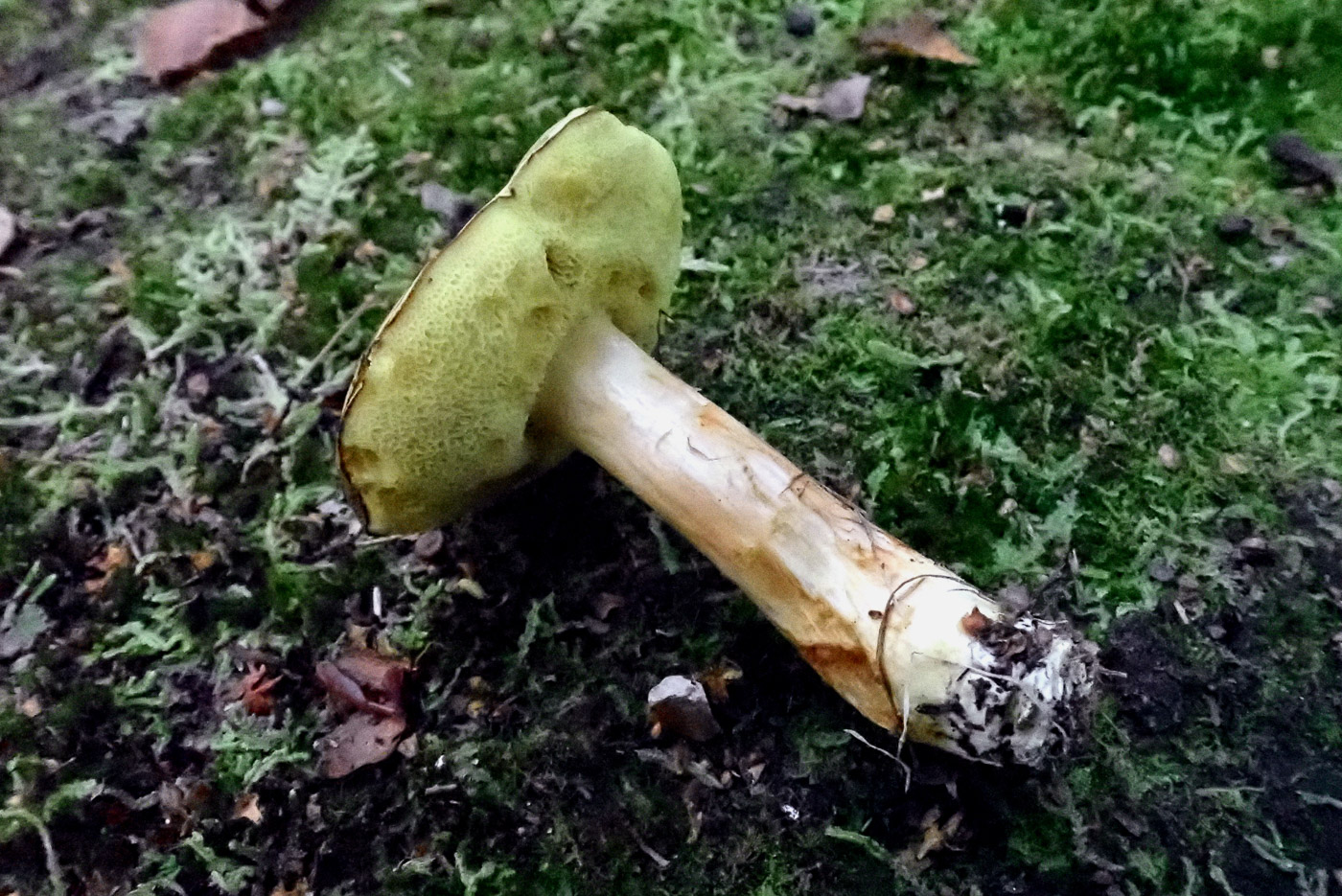
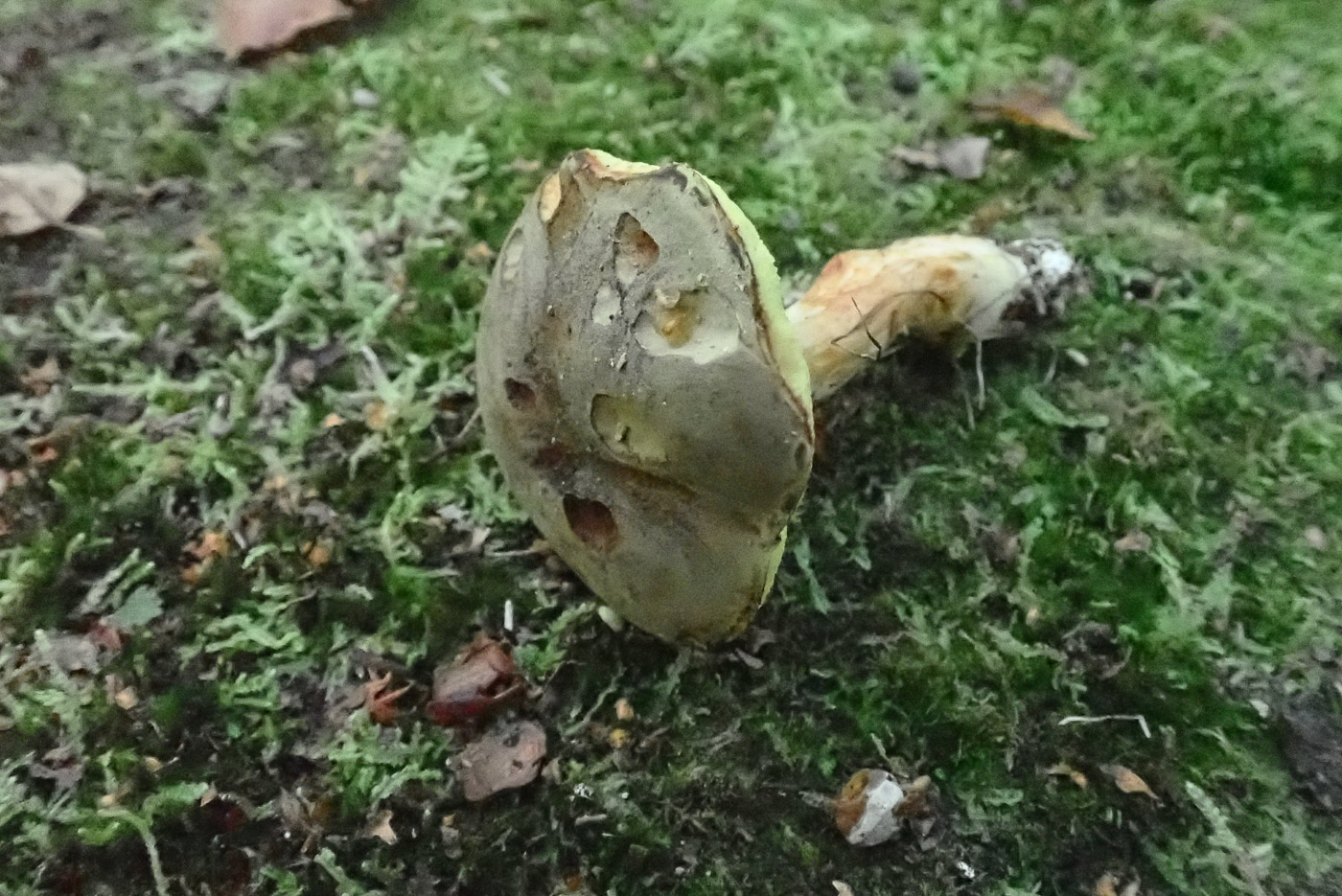 |
Nov 9, 2021. In soil under Birch in a grassy glade at Burnham Beeches Penny found this singleton and searched for a second to accompany it with no success. The cap was firmer than the much more common Xerocomellus species we regularly find, the surface was distinctly velvety with no cracking and also had olive green tones, the pores were bright yellow and failed to blue when pressed, the flesh (seen where the cap is nibbled) was white and not yellow, and the stem was more or less cylindrical and not enlarged at the top. All these feature point to this species rather than X. subtomentosus with which it is often confused. |

 |
Aug 18, 2021. In Wotton Park Estate Joanna Dodsworth and Derek Schafer found this singleton Bolete and though it appeared at first glance very similar to some other common boletes (e.g. Xerocomellus species) the reticulate markings on the stem quickly eliminated them, however. Penny is taking a risk here because the photos were named X. subtomentosus but she strongly suspects that it is in fact X. ferrugineus! The two are extremely similar and equally variable, but the latter often has a coarse brown network on the stem, the yellow pores tend to become dirty olivaceous, furthermore the flesh when exposed to air (seen here where the cap has been nibbled) remains white unchanged - all features visible in Joanna's two photos. Microscopic differences are slight so not that much help. The two species are clearly distinct when sequenced but without that evidence we cannot be absolutely sure which of the two this specimen belongs to. Apparently X. ferrugineus - though with fewer records - is the commoner of the two in Britain. Mycology doesn't seem to get any easier! |
| Xerocomus subtomentosus (Suede Bolete) |
 |
Oct 31, 2023. In Burnham Beeches Mario Tortelli found two nice examples of this Bolete - one which could easily be confused with the very common Xerocomellus group of looakalike species which we regularly struggle to name with confidence. The cap surface is almost velvety when young and fresh though colour is quite variable but when with a greenish tint as here it does look quite distinct. Tubes are bright yellow and turn blue when pressed, and the stem often has a network at the apex. When cut lengthways the cap flesh can turn yellowish, also faintly blue. Very similar is X. ferrugineus (in fact we were unsure which of these two species our previous Finds entries were) so its good to have today's confidently identified by Mario. (The photo is Jim Wills'). |



 |
Jul 16, 2023. In Bernwood Forest Jesper Launder came across these two and was able to name them in the field (though X. ferrugineus is very similar). Neither species has a common name despite being not that rare though both are easily mistaken for members of the Xerocomellus genus - all were originally in genus Boletus and need an experienced eye to recognise individually. Today's species has notably bright yellow fine pores which blue when pressed / damaged and the cap is somewhat variable in colour but notably 'felty'. The stem tends to taper below (not apparent here, though), can sometimes have a mesh / network and the pores tend to be slightly decurrent - just visible here. A difference between the two lookalike species: today's has cap flesh (when cut in half) with a yellowish, sometimes bluish tint; in X. ferrugineus the cap flesh remains +/- white. A week later at the same site Penny found this species in abundance under Oak (photos 3 and 4). |
| Xerula pudens (no English name) |
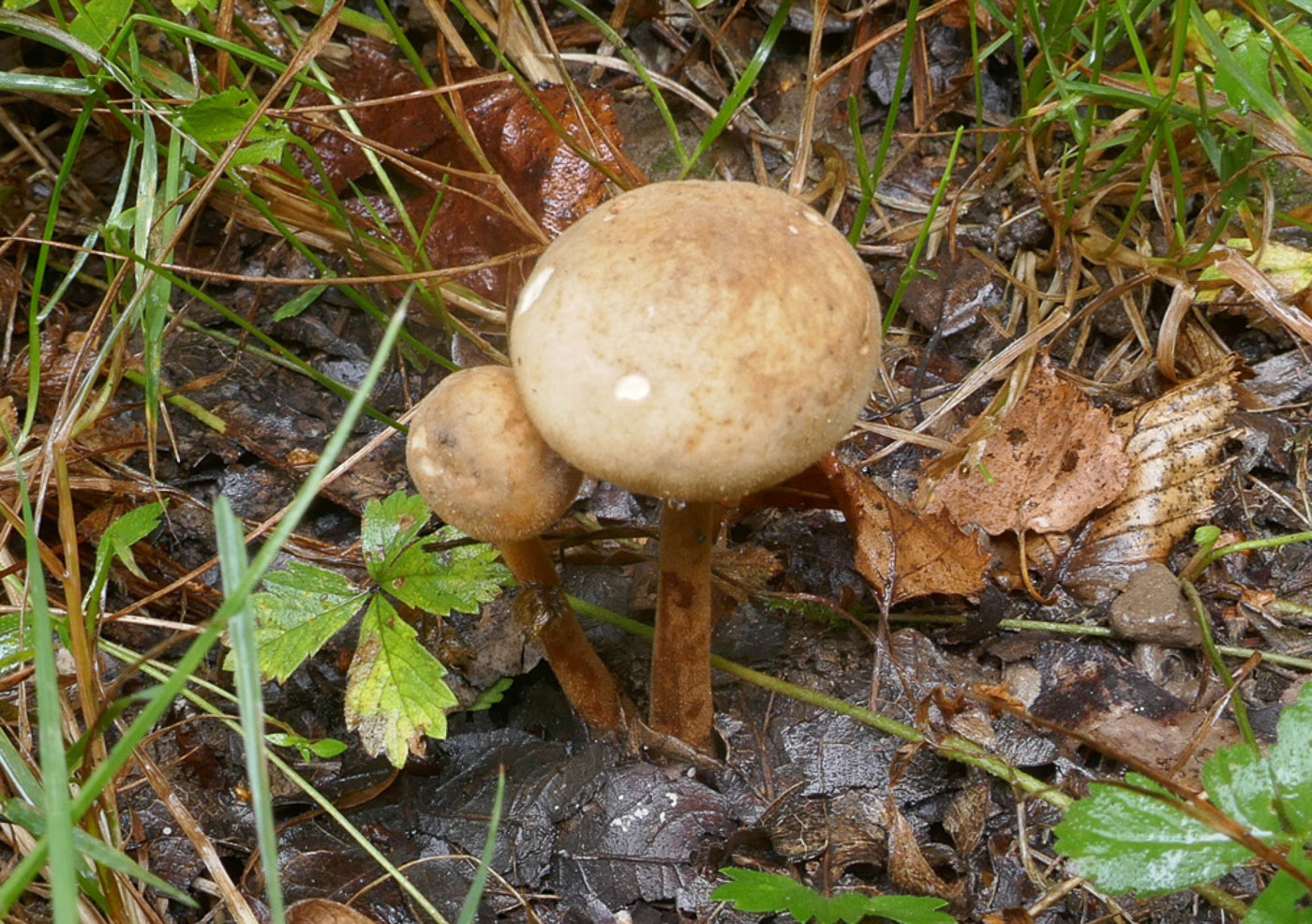
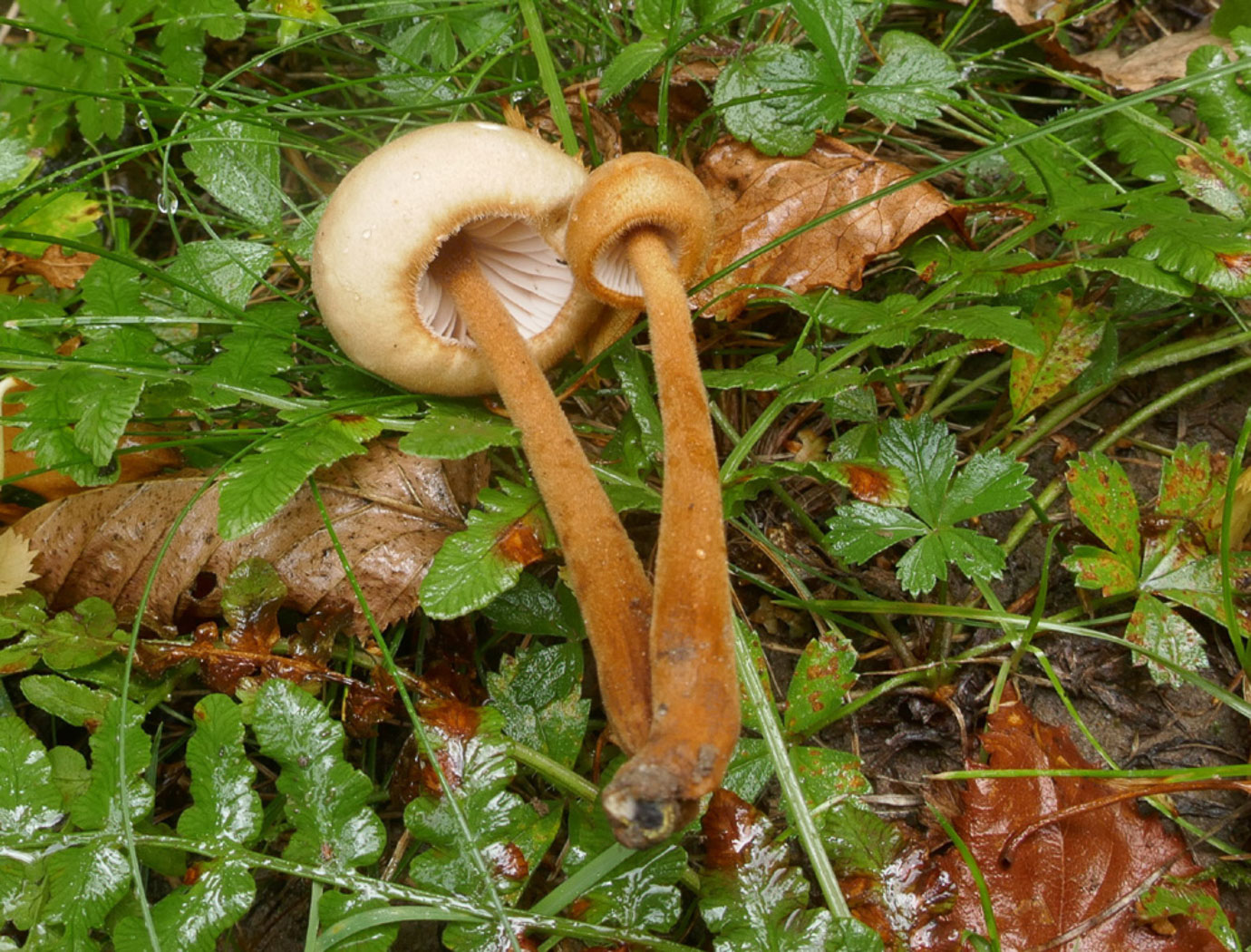
|
Sep 1, 2025.  At Stampwell Farm Jackie Ewan's daughter brought this collection to her attention, it was found along the edge of mixed deciduous woodland. Jackie's first thought was that it was Hymenopellus radicata (Rooting Toughshank) but on closer inspection the hairy cap margin and even hairier stem didn't fit. At home she discovered that X. pudens - a new species to her - has similar round but smaller spores than the Rooting Toughshank (now moved to genus Hymenopellis though for some reason today's closely related species remains in Xerula), and the spore size she found together with the hairy cap and stem fitted perfectly. This is only our second county record, the first being in 2020 from Wotton Park Estate. So this was a nice Find. At Stampwell Farm Jackie Ewan's daughter brought this collection to her attention, it was found along the edge of mixed deciduous woodland. Jackie's first thought was that it was Hymenopellus radicata (Rooting Toughshank) but on closer inspection the hairy cap margin and even hairier stem didn't fit. At home she discovered that X. pudens - a new species to her - has similar round but smaller spores than the Rooting Toughshank (now moved to genus Hymenopellis though for some reason today's closely related species remains in Xerula), and the spore size she found together with the hairy cap and stem fitted perfectly. This is only our second county record, the first being in 2020 from Wotton Park Estate. So this was a nice Find. |


 |
Sep 22, 2020. Martin Dodsworth found this rare species, new to the county, at Wotton Park Estate (photo Derek Schafer). Clearly similar to the very common X. radicata (now moved into genus Hymenopellis) which also arises from the roots of deciduous trees, the key difference to note is the finely but densely hairy to velvety stem (see detailed photo). Compare with that species, by chance also dated Sept 22nd. (2025 Additional note: As these two are so similar it is odd that X. pudens appears to remain in this genus when H. radicata was moved from Xerula in 2010?)
|
| Xylaria carpophila (Beechmast Candlesnuff) |
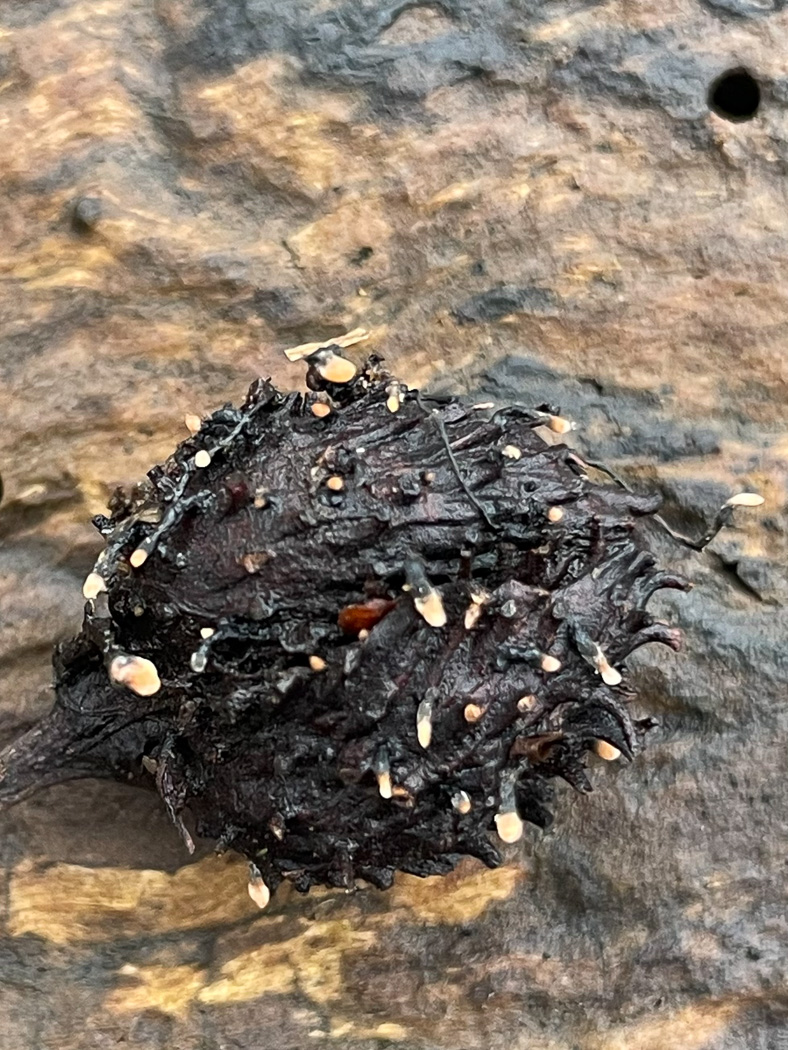
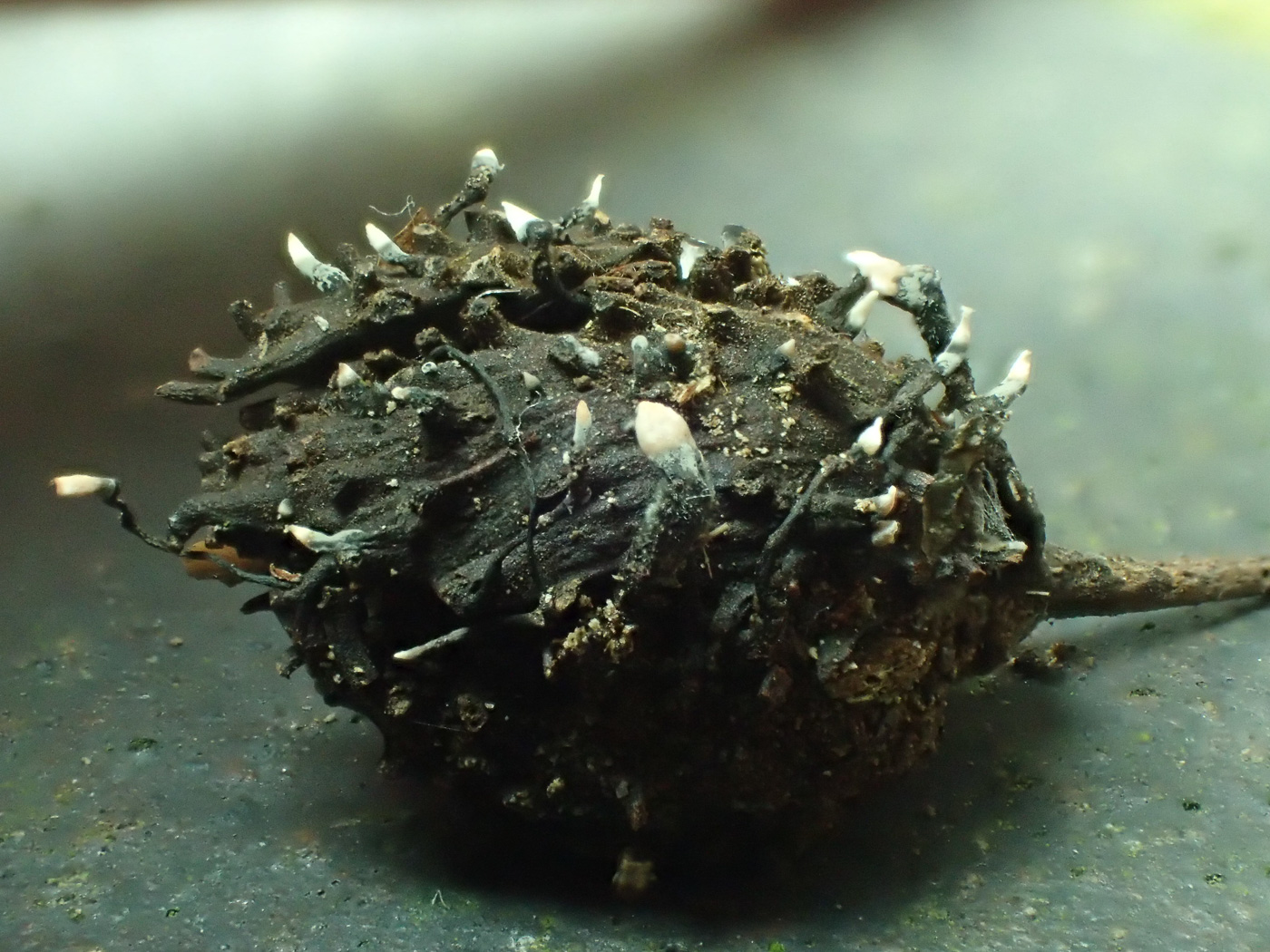
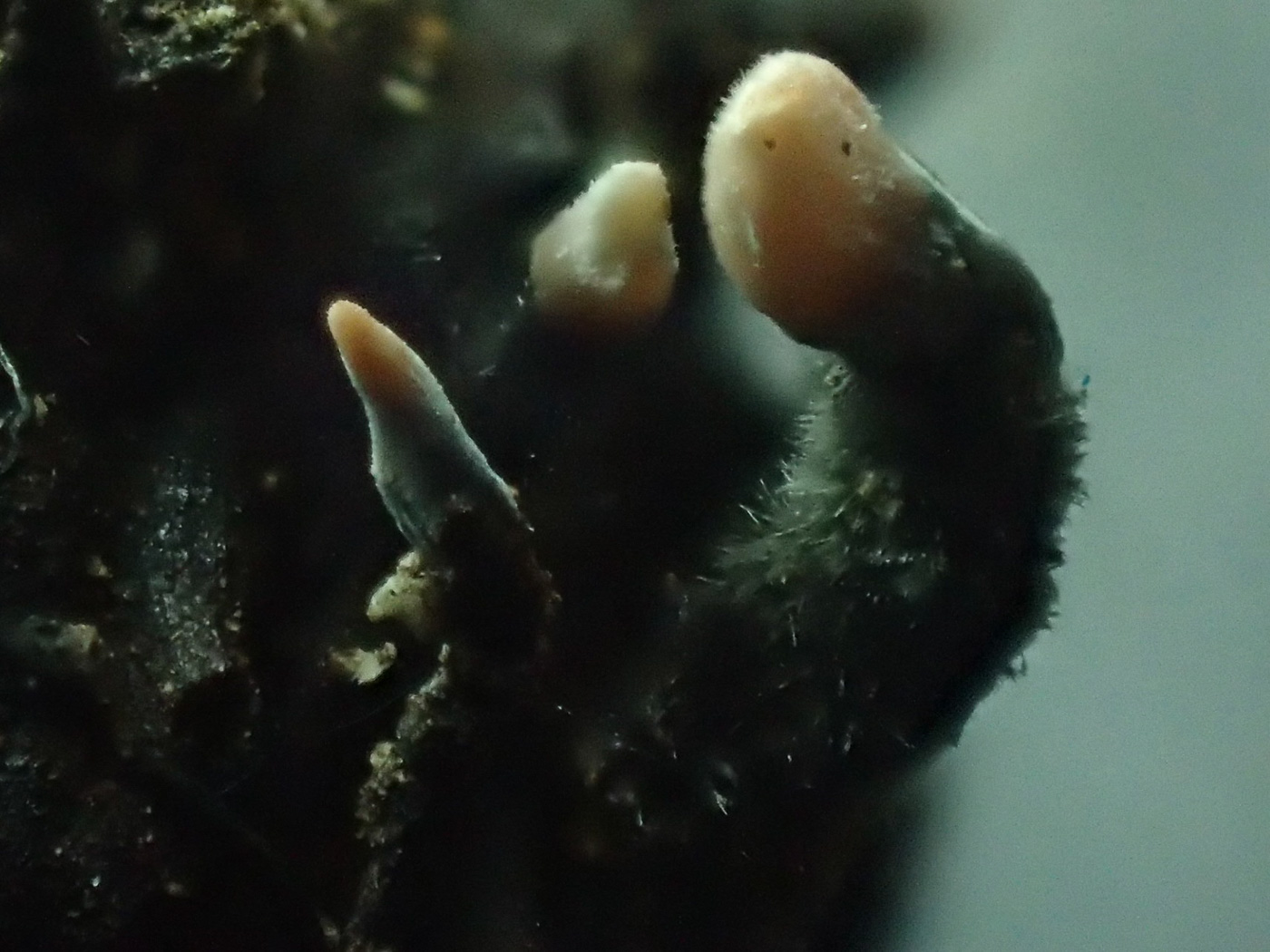 |
Feb 9, 2025. On farmland near Saunderton Sarah Ebdon found this delightful material of a springtime smaller version of our common Xylaria hypoxylon (Candlesnuff). As the name suggests it grows only on Beechmast and is therefore common in our area where Beech predominates.To find it you need to dig about in thick litter under Beech, looking for the telltale pink tips on the top of thin black strands, when young and fresh quite finely hairy as can be seen from Sarah's photos. |
 |
May 9, 2023. In the thick Beech litter at Turville Heath Penny searched around to find this tiny Candlesnuff species - one which is common at this time. It grows on the nut cupules and is clearly a miniature form of its 'big brother' seen below, ie a thin greyish furry spike with a peach pink tip. |

 |
Mar 27, 2021. At Turville Heath Penny removed the top dry layer of beechmast to uncover another very common springtime Ascomycete found solely on damp Beech cupules. Another 'bums on seats' species, this one is considerably smaller and less conspicuous than its better known relative X. hypoxylon (Candlesnuff) - the familiar autumn species often seen on fallen deciduous wood. Both species have a black stem with a creamy white spore-bearing top section but today's species is almost hair-thin having a fine spike at the top and the stem can be surprisingly extended depending how deeply buried in the mast its host cupule is. You often have to dig around under leaves to find this species but just need to focus on spotting the white tip amongst the mast (photo 1) and then carefully extracting the whole fungus attached to the cupule (photo 2). |
| Xylaria hypoxylon (Candlesnuff Fungus) |

 |
Nov 14, 2024. In Salden Wood Bob Simpson was intrigued by these somewhat skinny white threads emerging from the sawn end of a Hazel log. Was this really just the very common X. hypoxylon or could it be a different species from that genus, maybe H. filiformis, the name of which seemed to fit the bill but he could find no details about it? When he sent his photos round to a selection of colleagues for their opinions. Sarah Ebdon came up with the information that H. filiformis grows on herbaceous stems and leaf litter therefore was eliminated, also several of us have noticed this phenomenon this season with very thin whispy examples of X. hypoxylon appearing. It's been a funny season ................. |
 |
May 9, 2023. At Turville Heath Penny found many examples of the early stages of this species on fallen deciduous wood - one of the most familiar when fully mature and shiny black but much less often illustrated in it present form. See the Masterlist for examples of its very different mature appearance. |
 |
Jan 4, 2022. At Stampwell Farm on a fallen deciduous stick Jackie Ewan noticed this common species still looking quite fresh. |



 |
Nov 13, 2021. At Turville Heath under Birch Penny found this very common fungus but apparently on the ground rather than obviously on wood, and at first glance wondered if it was Clavulina coralloides (Crested Coral). Not so, it was clearly the Xylaria, black at the base and widening out towards the tips which were typical of this species and when given a flick a cloud of spores flew off. She did not investigate but therefore assumed they were growing on submerged wood or roots. |
| Xylaria longipes (Dead Moll's Fingers) |

 |
Sep 14, 2023.  At Turville Heath on a fallen deciduous log Penny spotted these distinctive black 'fingers' and, noting they were quite slim and had thin stems at the base, she checked the spores at home thus confirming it was this species rather than the much more common and fatter X. polymorpha (Dead Man's Fingers). (The spores are only half the size in X. longipes - a considerable difference!) Photo 2 shows an adjacent conjoined group of three - unusual but still the same species though looking much more like the larger thicker Dead Man's Fingers. At Turville Heath on a fallen deciduous log Penny spotted these distinctive black 'fingers' and, noting they were quite slim and had thin stems at the base, she checked the spores at home thus confirming it was this species rather than the much more common and fatter X. polymorpha (Dead Man's Fingers). (The spores are only half the size in X. longipes - a considerable difference!) Photo 2 shows an adjacent conjoined group of three - unusual but still the same species though looking much more like the larger thicker Dead Man's Fingers.
|
 |
Jun 25, 2022. Xylaria sp (either X. longipes or X. polymorpha). In Salden Wood Bob Simpson noticed this immature cluster of fruitbodies growing on a deciduous stump. It is often difficult to split these two very similar Pyrenomycete Asco species which can look extremely similar, the only safe way being a comparison of their spore sizes: those of the commoner X. polymorpha being much larger. However, in immature collections such as this it is likely that the spores will not be sufficiently developed to help!
|
| Xylaria polymorpha (Dead Man's Fingers) |
 |
Sep 13, 2020. Penny Cullington found this young collection of fruit bodies growing on fallen Beech at Pullingshill Wood. A common ascomycete, though very different from the softer fleshed cup fungi which are also in this Order of fungi, the solid black fruit bodies are covered with tiny ostioles (holes) through which the spores are forcibly expelled. The white structure within can be seen on the right hand fruit body which has been split open.
|
| Xylodon (previously Hyphodontia) sambuci (Elder Whitewash) |
 |
Jan 11, 2021. On part of Brill Common Joanna Dodsworth noticed this good example of one of the commonest corticioid fungi (those which are flat, don't form brackets, and often look like splodges of white paint on fallen wood). The genus Hyphodontia is large and nearly always needs a scope to identify to species but this aptly named species is so common on Elder - both living or fallen as here - that one can safely name it in the field though it does occur on other deciduous woods as well.
|



























































